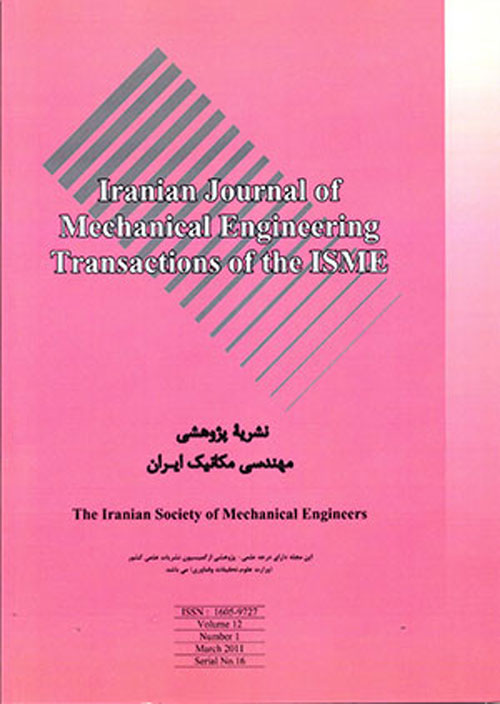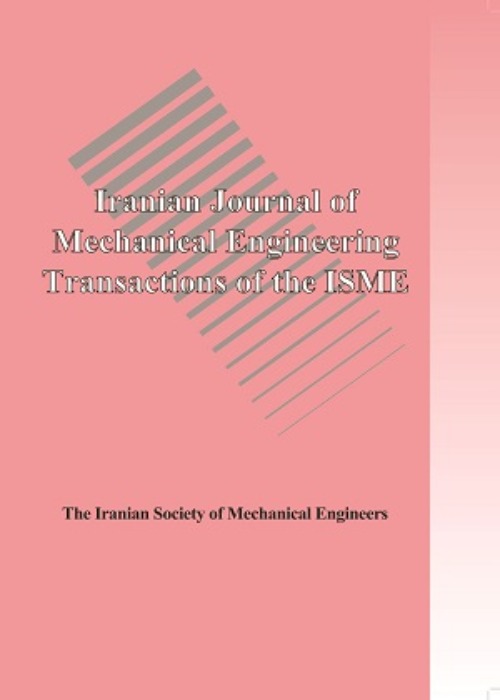فهرست مطالب

Iranian Journal of Mechanical Engineering Transactions of ISME
Volume:22 Issue: 1, Mar 2021
- تاریخ انتشار: 1399/12/28
- تعداد عناوین: 7
-
-
Pages 7-26The aim of this research is to present a thermo-economic model of an indirect hybrid system of solid oxide fuel cell and micro gas turbine to be used in the combined heat and power generation system. In order to have more accurate results, complete electrochemical, thermal, and thermodynamic calculations in the fuel cell are conducted. Complete electrochemical, thermal, and thermodynamic calculations in the fuel cell are calculated. The results show that the overall efficiency of indirect hybrid system is almost 56% and its electrical efficiency is around 39%. On the thermo-economic results, it can be said that the cost of power generation based on the Lazaretto’s simple model is about USD 14.93 cents/kWh and, based on the full economic model, it is about 22.89 cents/kWh. The purchase and installation cost of the hybrid system is about 1972 USD/kW.Keywords: Cogeneration System, Hybrid system, Micro turbine, Solid oxide fuel cell, Thermo-economic
-
Pages 27-41Due to the growing utilize of lightweight materials and the wide use of resistance spot welding in the several industries, in this study was investigated the effect of welding parameters on residual stresses of resistance spot welding of AZ31 magnesium alloy. Resistance spot welding is a complicated multi-regime phenomenon which simulated by a developed electro-thermo-mechanical coupled finite element model. The importance of the parameters interactions was determined by using design of experiment method (DOE). The FE model used to predict temperature changes, nugget growth, and the residual stresses distribution. For validation, the results of the simulation were compared with experimental data, based on the nugget diameter at the direct current (DC) and alternating current (AC) conditions. The results showed that by increasing current and welding time the residual stresses are reduced. Increasing electrode force causes to increase residual stress but increasing holding time causes to create a peak in the amount of residual stresses. Also, evaluation of current sources revealed, in the same conditions, using direct current creates less residual stress than alternating current.Keywords: Resistance spot welding, Residual Stress, DOE, FE model, Magnesium alloy
-
Pages 42-53An experimental investigation has been performed to examine the heat transfer enhancement achieved by helically coiled wire inserts during forced convective condensation of R-600 vapor inside horizontal tubes. The experimental setup is a vapor-compression refrigeration cycle. This system includes a main condenser which is a coaxial double-pipe counter-flow heat exchanger with water as a coolant. To reach the favorable vapor qualities, pre-condenser and after-condenser systems were invoked. Experiments were carried out for plain tube and five different coiled wire inserted tubes. At each test, various parameters were measured like refrigerant mass flow rate, inlet and outlet water temperature of the condenser, refrigerant pressure, etc. Using the acquired data, heat transfer coefficients were calculated for different tubes. Investigation of the results showed that increasing the thickness of the wires can augment the heat transfer rate. Also, it is seen that reducing the coil pitch can enhance the heat transfer rate as high as 31.6%. Also, it was seen that employing coiled wire inserts inside the tube, increases the average heat transfer coefficient up to approximately 80% regarding the plain tube results.Keywords: Coiled wire, Enhanced heat transfer, R-600 refrigerant, Condenser
-
Pages 54-73This paper presents an innovative idea to the noise control problem for broader absorption bandwidth at low frequencies. For this aim, Helmholtz resonator array (HRA) designed based on Fibonacci sequence, which is addressed “Fibonacci based-HRA”. First, to validate the simulations which were performed through finite element method (FEM) as a numerical method in COMSOL Multi-physics software (Version 5.2), the results have been compared with experimental results which obtained by other researchers for two cases: (1) one unit resonator, and (2) four resonators array block with equal size. Second, to examine the performance of sound absorption of Fibonacci based-HRA, the results obtained for HRA with equal sizes of the 4, 6, 8 and 10 component resonators, compared with those obtained for Fibonacci based-HRA with the same number of the component resonators and the same overall dimensions of HRA block. The comparison showed that Fibonacci based-HRA approach is a good candidate for broad-band low frequency noise control.Keywords: Fibonacci based Helmholtz resonator array (Fibonacci based-HRA), Sound absorption coefficient, broad-band low frequency noise control, Finite Element Method (FEM)
-
Pages 74-89
In continuous systems such as rods, cables, and shafts, the differential equation governing the behaviour of the structure can be obtained by applying Newton's second law. Only a limited group of these equations have an analytic solution; hence the provision of efficient and stable numerical methods is of particular importance. The method used in this study is a nonstandard finite difference (NSFD) scheme, which is an effective numerical method for solving the above-mentioned equations. One of the important features of this method is its relatively good high accuracy. Results obtained by nonstandard finite difference methods are more compatible with the exact behaviour of the problem than that of the standard finite difference method. In this research, the equations governing the vibrations of cables with three different boundary conditions are solved. Three solutions including the analytical solution, the standard finite difference method (SFD) and the NSFD method are compared. Results show that the error of the NSFD is significantly less than of the SFD.
Keywords: Vibrations, nonstandard finite difference, cable, Numerical Methods -
Pages 90-107
This paper aims at developing a new cylindrical shell element, called shell superelement. The element is defined based on the classical shell theory, and it consists of eight nodes each with six degree-of-freedoms (dofs). In this element, the trigonometric shape functions are incorporated along the angular direction of element while polynomials were used in other two directions. Therefore, there is no need for meshing a shell structure with cylindrical geometry through the angular direction. This property helps an engineer to deal with complicated analyses on cylindrical shell structures with less number of dofs. At the end, the defined element is used in the stress analysis of two different classical shell problems and the results are compared with the ones reported in the literature, and obtained by means of shell elements in a commercial software package.
Keywords: Cylindrical Shell element, Superelement, Trigonometric shape functions, Structural analysis -
Pages 108-126
The phenomenon of capturing of sharp gradients, shock waves, and contact discontinuities in compressible aerodynamic flows is the major concern while numerical methods based on the characteristic variables are favorable solutions. The aim of the present study is to introduce a method based on the characteristic variables (Riemann solution) and control the diffusion term in the classic methods in order to capture the shock waves. An efficient blending procedure based on the densitybased algorithm is presented to solve the compressible Euler equations, using a non-orthogonal mesh with collocated finite volume formulation. The fluxes of the convected quantities are approximated by employing the characteristic based total variation diminishing (TVD), artificial compressibility method (ACM) and Jameson methods. Results show that the ACM and TVD methods captured the shock waves with higher resolution than the Jameson method. Moreover, not only quality of shock wave capturing was improved for all flows at the discontinuities by employing ACM and TVD methods, but also the computational time and convergence were improved for the supersonic flows.
Keywords: Shock wave, Riemann solution, ACM, TVD, Jameson


